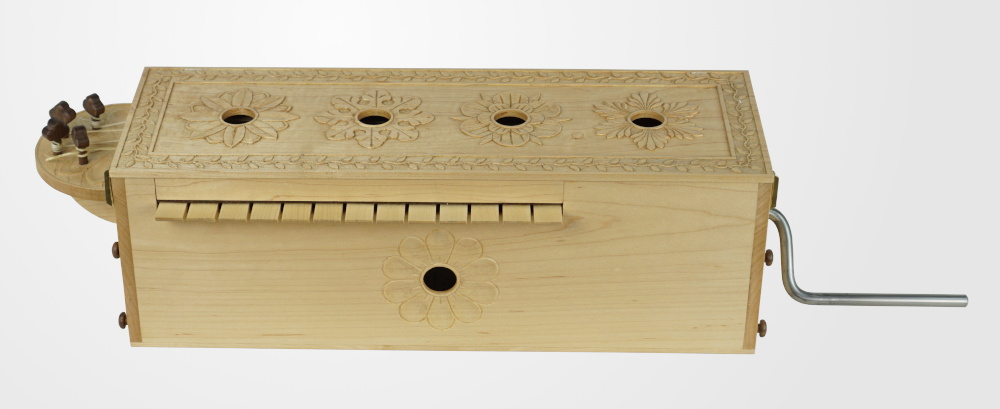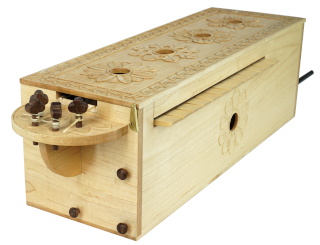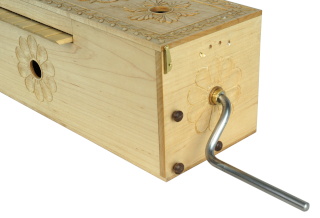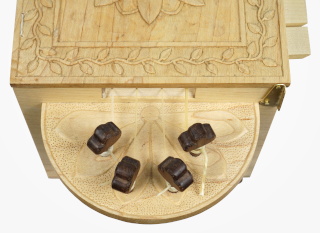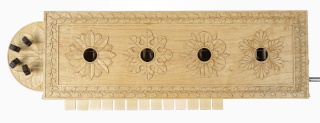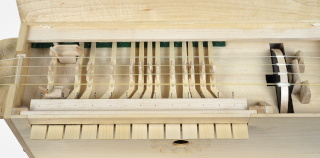
|
Luttrell Symphony |
|
Luttrell Symphony
This symphony, commissioned by Ian Pittaway, is a result of his extensive research into medieval illustrations and carvings depicting symphonies. One peculiarity is that some of them are shown with the keyboard at the top, facing the player, not along the lower edge, where one would expect an organistrum or hurdy-gurdy keyboard to be. These depictions also show equal width keys extending right across, or almost right across, the top edge. If just one symphony were depicted in this way, it could be dismissed as an artist's error, but roughly half of all depictions of symphonies show this top-mounted keyboard. We entered into lengthy discussions about whether this was possible, and if so, how such a thing would work.
Medieval illustrations and carvings of symphonies with top-mounted keyboards. Click on the image to enlarge. In a hurdy-gurdy, the keys are simply rectangular strips of wood that slide up and down in holes, pressing the tangents onto the string to make the notes, and falling back by gravity. The keys get smaller as one ascends the scale, because the key tangents act as frets. It's a simple and time-tested principle, but it was clear that the internal mechanism on this symphony would need to be a good deal more complex. Ieventually came up with a keyboard similar to a clavichord, with canted key levers that allow a regular row of keys of equal width to stop a string at the irregular positions demanded by a diatonic sequence of frets. I added return springs to the keys, because many of the illustrations show the instrument being played with the lid vertical. Gravity won't do the job in that orientation. The intial, obvious idea was for the keys to lift tangents vertically onto the strings from below, exactly as a clavichord does. This didn't work. The tangent tended to reduce string pressure on the wheel, causing weak tone and squealing. I eventually invented heavily sloped tangents that touch the strings from the side. That cured the problem without resorting to more complex mechanisms.
What emerged was a versatile instrument, tuned as follows :
Twin chanterelles in c'.
The compass is c' to a''. There are keys for both b natural and b flat, which is useful for some medieval tunes that require both. (This is optional, of course, if you prefer a pure diatonic row.) Tenor drone in f with capos to change to g or a. Bass drone in c with a capo to change to d. Useful drone combinations are : f and c drones for tunes in Lydian, Hypolydian, or transposed Ionian mode (with fixed b flat). g and c drones for tunes in Ionian mode. g and d drones for tunes in Myxolydian mode. a and d drones for tunes in Dorian mode. The instrument is more powerful, less contemplative than a "standard" symphony with its single chanteretlle. I named it the "Luttrell Symphony" because the Luttrell Psalter is a major source of the illustrations on which I based it. GalleryClick images to enlarge. Prices
To order or enquire, pleasecontact me Cases - Excellent cases can be ordered from specialist manufacturers such as Kingham MTM, but they're pricy. I can supply an attractive, custom-built plywood case, black with chrome fittings, for £220 when ordered with an instrument. Delivery - the price depends on where you live. Please enquire. I hate it when websites say "Phone for a quote", so to give you some idea - getting a baroque guitar in its case to America, including insurance, is currently about £170. Getting one to Kent is about half that. Waiting time, from placing an order to clutching your new baby, is currently about 16 months. It's very approximate, because the schedule often contains items that are somewhat experimental, and they may take more or less time to complete than anticipated. Usually more. Deposit- I usually ask for £150 (non-returnable unless I'm dead, insane, incapacitated or incarcerated) to secure an order and cover materials. Once that's paid, your order is entered into my Magic Book. Nothing happens for several months, then you receive an email to tell you I've started construction. A few weeks later, a big parcel arrives, and you squeal with delight.
Anote on HUMIDITY - delicate wooden instruments are remarkably resilient, but
they can have major problems with both high and low atmospheric humidity levels. I keep my workshop at the
recommended humidity level, between 45% and 50%, and I strongly recommend that instruments are kept as close
to that range as possible. Electronic humidity meters are available cheaply on the Internet. They're small enough
to keep in your instrument's case. |

More Instruments |

Diabolus Homepage |
|

Email for Diabolus |
